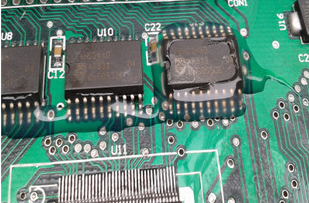The strength of SMT placement machine is reflected
Mounting speed refers to the installation time of each component within a certain range, and the rack is fixed. Chip devices are currently mounted on high-speed computers. Speed: 0.06-0.03s: Multi-function machines are generally medium-speed machines. The mounting speed of QFP is 1 to 2s, and the placement speed of chip components is 0.3 to 0.6s. The current multifunction machine can also reach within 0.2s. If for high-volume SMT placement, the higher the placement speed, the higher the delivery rate.
1. Mounting speed
Mounting speed refers to the installation time of each component within a certain range, and the rack is fixed. Chip devices are currently mounted on high-speed computers. Speed: 0.06-0.03s: Multi-function machines are generally medium-speed machines. The mounting speed of QFP is 1 to 2s, and the placement speed of chip components is 0.3 to 0.6s. The current multifunction machine can also reach within 0.2s. If for mass smt placement, the higher the placement speed, the higher the delivery rate.
According to the IPC9850 standard (acceptance standard of placement machine), the placement speed is expressed in CPH, that is, the number of parts placed in the 200mm*200mm placement area per hour. Large components (such as chip components and QFPS) are mounted at different speeds. For example, the mounting speed of chip components is greater than or equal to 12000 cph, while the mounting speed of QFP is greater than or equal to 1800 cph.

2. Mounting angle
The mounting angle is generally 0° to 360°, and the resolution is 0.1° to 0.001°.
3. Absorption rate of components
Component suction rate refers to the ability to accurately pick and place. Expressed in %, the larger the better. For example, the component suction rate is 99.9%, that is, less than 1 component is allowed to be placed and placed for 1000 components. Less throwing rate is the key to testing product quality for SMT chip processing.
Fourth, the mounting area
The placement area depends on the transfer trajectory of the placement machine and the movement range of the placement head. Generally, the minimum PCB size is 50 mmx50 mm, and the maximum PCB size should be greater than 250 mmx30 mm. The maximum mounting area of machines of different manufacturers is different. The maximum PCB size of the same type of machine is usually divided into three specifications: large, medium and small.
The purpose of the placement machine
The placement machine is also called "surface mount system" and "placement machine". Generally in the production line, the placement machine is a device that is equipped with a glue dispenser or a screen printer and then moves the placement head to accurately place the surface-mounted components on the PCB pads.
The following briefly introduces several types of placement machines
Type one, smt placement machine
SMT placement machine is the fourth generation of electronic assembly technology, its advantages are high component installation density, easy to achieve automation, improve production efficiency, and reduce costs. The SMT production line consists of three processes: screen printing, component placement, and reflow soldering. The placement of SMC/SMD is an important part of the entire surface mount process.
Type two, LED placement machine
The LED placement machine is a SMT placement equipment specially designed for the LED industry to achieve mass LED circuit board assembly. It uses the principle of guide rail or linear motor to control the drive head, and at the same time, it must be equipped with a professional spunbonded nozzle head, so that during the placement process, the production defects such as sticking and throwing can be eliminated as much as possible, and its stability and service life can be guaranteed.
Category three, automatic placement machine
As the name suggests, the automatic placement machine is a placement machine that is fully automated and does not require manual positioning.
The automatic placement machine is used to realize high-speed, high-precision and automatic placement of components. It is a key and complex equipment in the entire SMT production.
What does the placement machine do? How does the placement machine operate?
The first step is to draw a picture. Use the picture of the PCB to make an image plate, print it on the circuit board, and then corrode, so that the basic circuit of the circuit board comes out, then punch through holes and print silk screen.
The second step is to compile a positioning program on the placement machine. The positioning program is based on the MARK points drawn in advance on the circuit board, so that the flux is applied after the program is programmed. That is, all the places on the circuit board that need to be soldered are covered on the PCB board with a mesh board made for this circuit board. The holes made on the stencil can be coated with flux (tin paste) on the PCB, and then use the placement machine to paste the components on the PCB board, and reflow soldering, so that the components are soldered on the PCB board.